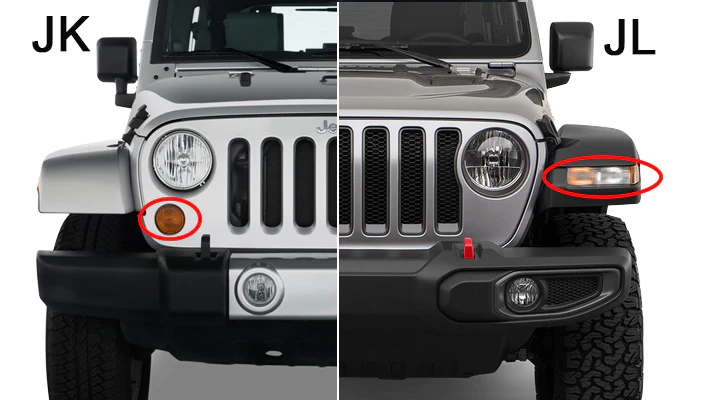Jeep Wranglers have long been the go-to vehicle for off-road enthusiasts and those who love the blend of rugged functionality and classic style. In recent years, the Wrangler has seen significant updates, particularly with the introduction of the JL model in 2018, which succeeded the JK model that had been in production since 2007. For the untrained eye, distinguishing between the JK and JL models can be challenging, but there are several key differences, primarily in their appearance, that can help you tell them apart.
Exterior Design
Grille and Headlights

The most noticeable difference between the JK and JL Wrangler is in the front grille and headlights. The JL features a slightly kinked grille at the top, giving it a more dynamic look compared to the straighter grille of the JK. Additionally, the JL's headlights intrude slightly into the outer grille slots, a design change not present in the JK.
Turn Signal
In the Jeep JK, the turn signals are located on the grille, next to the headlights. This is a key feature of the JK model. The grille itself has a classic Jeep design with seven vertical slots.
The Jeep JL, which is a newer model, has its turn signals positioned on the fender flares, not on the grille. This is a significant design change from the JK model. Additionally, the JL has a slightly different
Fender Flares and Vents

Another distinction lies in the fender flares. The JL has larger and more pronounced fender flares compared to the JK. Also, the JL features a vent on the side of the cowl, just behind the fender flares, which is absent in the JK. This vent is not just a stylistic addition; it helps reduce wind noise and improve aerodynamics. Related Articles: The Most Expensive Jeep Wrangler: 2023 Wrangler Rubicon 392 20th Anniversary
Windshield and Hood Latches
The windshield design is another area where the JK and JL differ. The JL has a more raked windshield, which improves aerodynamics. The method of folding down the windshield has also been simplified in the JL, requiring the removal of fewer bolts compared to the JK. Additionally, the hood latches on the JL are positioned closer to the front of the vehicle, whereas on the JK, they are closer to the cabin.
Tail Lights and Rear Bumper


At the back, the differences continue. The JL's tail lights are distinctively different, with a more square-like design incorporating reverse lights, unlike the JK's round reverse lights. The rear bumper of the JL is also slightly different, with a more integrated and streamlined design.
Interior Design
Dashboard and Infotainment

Inside, the changes are more pronounced in the JL. The dashboard design is more modern and user-friendly, with upgraded materials and a more sophisticated layout. The infotainment system in the JL is more advanced, with larger touchscreen options and more connectivity features.
Controls and Storage
The JL also boasts improved ergonomics, with more conveniently placed controls and additional storage spaces. The gear shift and handbrake are more refined in the JL, offering a better tactile experience.
Performance and Capability
While performance and capability differences are not immediately visible, it's worth noting that the JL introduced some mechanical improvements over the JK, including engine options, transmission upgrades, and enhanced off-road capabilities.
Conclusion
Identifying whether a Jeep Wrangler is a JK or JL model can be straightforward if you know what to look for. The key lies in observing the details in the grille, headlights, fender flares, windshield, and tail lights. While both models retain the iconic Wrangler look, the JL brings a more modern and refined twist to this classic design. Whether you're a potential buyer or just a Jeep enthusiast, understanding these differences can enhance your appreciation of what each model has to offer.


